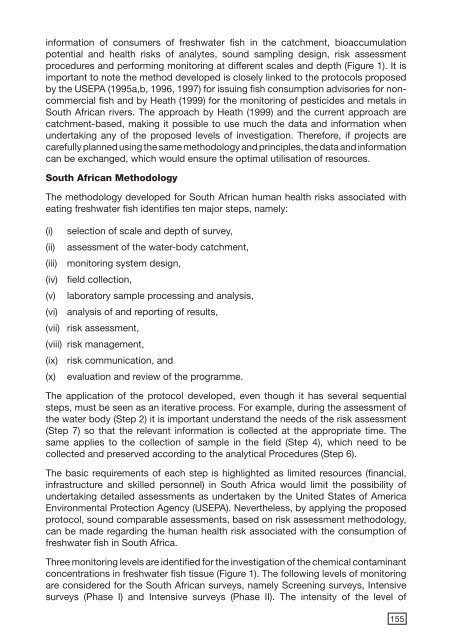Download as a PDF - CiteSeerX
Download as a PDF - CiteSeerX
Download as a PDF - CiteSeerX
You also want an ePaper? Increase the reach of your titles
YUMPU automatically turns print PDFs into web optimized ePapers that Google loves.
information of consumers of freshwater fish in the catchment, bioaccumulation<br />
potential and health risks of analytes, sound sampling design, risk <strong>as</strong>sessment<br />
procedures and performing monitoring at different scales and depth (Figure 1). It is<br />
important to note the method developed is closely linked to the protocols proposed<br />
by the USEPA (1995a,b, 1996, 1997) for issuing fish consumption advisories for noncommercial<br />
fish and by Heath (1999) for the monitoring of pesticides and metals in<br />
South African rivers. The approach by Heath (1999) and the current approach are<br />
catchment-b<strong>as</strong>ed, making it possible to use much the data and information when<br />
undertaking any of the proposed levels of investigation. Therefore, if projects are<br />
carefully planned using the same methodology and principles, the data and information<br />
can be exchanged, which would ensure the optimal utilisation of resources.<br />
South African Methodology<br />
The methodology developed for South African human health risks <strong>as</strong>sociated with<br />
eating freshwater fish identifies ten major steps, namely:<br />
(i) selection of scale and depth of survey,<br />
(ii) <strong>as</strong>sessment of the water-body catchment,<br />
(iii) monitoring system design,<br />
(iv) field collection,<br />
(v) laboratory sample processing and analysis,<br />
(vi) analysis of and reporting of results,<br />
(vii) risk <strong>as</strong>sessment,<br />
(viii) risk management,<br />
(ix) risk communication, and<br />
(x) evaluation and review of the programme.<br />
The application of the protocol developed, even though it h<strong>as</strong> several sequential<br />
steps, must be seen <strong>as</strong> an iterative process. For example, during the <strong>as</strong>sessment of<br />
the water body (Step 2) it is important understand the needs of the risk <strong>as</strong>sessment<br />
(Step 7) so that the relevant information is collected at the appropriate time. The<br />
same applies to the collection of sample in the field (Step 4), which need to be<br />
collected and preserved according to the analytical Procedures (Step 6).<br />
The b<strong>as</strong>ic requirements of each step is highlighted <strong>as</strong> limited resources (financial,<br />
infr<strong>as</strong>tructure and skilled personnel) in South Africa would limit the possibility of<br />
undertaking detailed <strong>as</strong>sessments <strong>as</strong> undertaken by the United States of America<br />
Environmental Protection Agency (USEPA). Nevertheless, by applying the proposed<br />
protocol, sound comparable <strong>as</strong>sessments, b<strong>as</strong>ed on risk <strong>as</strong>sessment methodology,<br />
can be made regarding the human health risk <strong>as</strong>sociated with the consumption of<br />
freshwater fish in South Africa.<br />
Three monitoring levels are identified for the investigation of the chemical contaminant<br />
concentrations in freshwater fish tissue (Figure 1). The following levels of monitoring<br />
are considered for the South African surveys, namely Screening surveys, Intensive<br />
surveys (Ph<strong>as</strong>e I) and Intensive surveys (Ph<strong>as</strong>e II). The intensity of the level of<br />
155

















